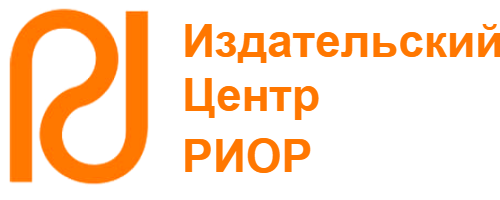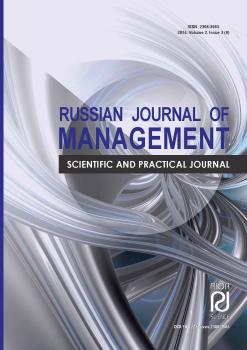SRO Rossiyskoe obschestvo ocenschikov (Ekspert)
from 10.11.2013 until now
OOO "A-Finans Grupp" (Gen. direktor)
from 15.01.2008 until now
SRO Rossiyskoe obschestvo ocenschikov (Ekspert)
from 10.11.2013 until now
Moskva, Russian Federation
Russian Federation
CSCSTI 06.39
CSCSTI 06.52
CSCSTI 06.81
The present research article explores experience of disputable situations relating to intellectual property objects (hereinafter referred to as IPO). Particular attention has been given to business valuation as a primary way to ensure security of a company. The immediacy of the present article resides in the fact that the intellectual property rights increasingly become an important asset of enterprises making up a key corporate asset. It is explained by frequent occurrence of conflicts of private interests relating to concrete intellectual property objects and their direct impact on the company value and future activities.
results of research and development, intellectual assets, intangible assets, company capitalization, economic security of business
Over the past years a sharp rise in infringement of intellectual rights is observed, in this respect many infringements do not come to trial and they are settled in the process of out-of-court dispute resolution. The system for international protection of intellectual property and results of intellectual activity is headed by the World Intellectual Property Organization (WIPO) being one of specialized agencies in the system of the United Nations Organizations. The report of 2017 on the situation in the area of intellectual property in the world Intangible Capital in the Global Value Chains (WIPR 2017) addresses the issue of a share of revenue in the global value chains accruing to a man power, immaterial capital and intangible assets within the bounds of all production activities forming one fourth of the global economic activity. “Intangible capital will increasingly determine the fate and fortune of firms in today's global value chains”, said WIPO Director General Francis Gurry.
“It is behind the look, feel, functionality and general appeal of the products we buy and it determines success in the marketplace. Intellectual property, in turn, is the means by which companies secure the competitive advantage flowing from their intangible capital”. [11] In order to deduce these economic indices, national accounts and statistics of international trade for all countries of the world and also data of companies have been analyzed. Practical situations arising virtually from the moment of establishing commercial companies are the confirmation of the immediacy of this direction. In 1976, when the company Polaroid brought a suit, patent disputes were not such a large business as they have become at present. So, the Ford Motor Company faced competition of the car makers’ syndicate pretending to monopoly in this sphere. In 1879, George B. Selden patented the car project, in fact it did not exist; it was only a description of main principles. The lawsuit against the Ford Motor Company initiated by George B. Selden lasted from 1903 till 1911. One of mechanisms of competitive struggle reducing economic security of the company was the threat to buyers of Ford’s cars to be summoned to appear before court. After losing the case, only after the retrial the court decided that none of car makers had violated the rights of Selden as they had used the engine of another design. Ever since the situation in the intellectual property market has definitely changed. The number of patent disputes is increasing.
For the last 20 years according to the data of patent organization Article One Parthers, the number of patent disputes has increased by more than 230%. [2] Based on the established practice many companies try to ensure a high level of economic security by registering all intellectual property objects in the manner prescribed by the laws and also by carrying out valuation of the exclusive rights to the IPO. In connection with this it is expedient to propose the following concept for ensuring business protection by implementing the following mechanisms of intellectual property objects management related to the valuation of the IPO. Valuation of the IPO of a company includes several stages: The 1st stage is an audit (inventory accounting) of intellectual property objects (Intangible assets) of a company. Based on the results of the conducted inventory accounting, a scorecard of Intangible Assets is prepared that allows for identifying the composition and structure of intellectual assets of a company for subsequent accounting and entering of them on the balance sheet and also valuation and analysis.
The conducted inventory accounting (audit) gives an opportunity to reveal problems associated with the functioning of IPO’ components of a company. 2nd stage is valuation of an intellectual potential and its components The given stage consists of the following:
1. The analysis of components forming a company’s intellectual potential;
2. Valuation of each component being a part of a company’s IPO;
3. Preparing a preliminary report on valuation of a company’s IPO. The valuation methodology depends on the type of IPO; however, particular attention is given to valuation of the IA related to human capital assets as the base of a company’s intellectual potential. Results are documented by a valuation report. There are 3 approaches used for valuation.
The cost approach (consists in calculating the value of full costs for reproduction of the appraised intellectual property and IA).
- The replacement value method;
- The replacement cost method.
The given approach has the advantage in appraising unique appraisal objects and technologies not being used for deriving commercial benefits. The income approach. When calculating the market cost of the IPO, the income approach methods are directed to determine economic benefits expected from its use. The given approach stipulates determining the value of intangible assets by calculating the present value of anticipated benefits. The anticipated benefits may be based on accounting the real economic impact from a licensed product. Valuation methods: - The direct capitalization method assumes that in future all income of an enterprise will be of a constant value.
It is appropriate for a stable business.
- The cash flow discounting method – there are very often cases when anticipated income of an enterprise from use of the IA will significantly differ for the period of its use. The comparable approach. The given approach is based on the comparative sales analysis; the principle of effectively functioning market, in which investors buy and sell similar type of assets, lies at the heart of it. Data for similar transactions are compared with a similar asset. Considering that the IA are very complex and specific assets being very often an integral asset of the whole operating enterprise, in association with this the comparable approach is used seldom and only for the specific IA. Valuation methods:
- The purchase cost method;
- The sales comparison method. In order for the IA to have a market value it must offer a certain measurable extent of rights and benefits to its owner. Patenting of inventions, registration of trademarks, formalizing legal protection of other results of intellectual activity (hereinafter referred to as RIA) grant their owner the monopoly power to draw income, sell, lease, prohibit using them by other persons, to apply in the capacity of legal remedies.
The 3rd stage is registration of the IPO for management accounting followed by IPO reporting. Registration for management accounting includes development of the following documents:
- The regulations for maintaining IPO management accounting of a company;
- The document control when maintaining IPO accounting;
- The forms of IPO management accounting. The 4th stage is company value management by means of ensuring business security on account of available IPO.
The base of a company’s IPO management is a process of converting knowledge, experience into the value. At this stage the interrelation of the IPO with other company’s assets and also the impact on business processes and security is analyzed. Conclusions: The given concept of a company’s IPO cost management will give an opportunity: 1. To use the IPO being a key asset of modern business in current activities of a company that, first of all, will ensure security of business and provide company with competitive advantages and also will ensure protection from impact of adverse internal and external factors. 2. To manage a company value and to increase a company value at the cost of rise in value of a company’s IPO. 3. In legal terms secured business opens opportunities for bringing in investments for a company. Thus, the concept of the value of a company’s IPO will help to bring business to a new qualitative level of development and growth on account of a company’s value management and ensuring business security.
1. I.V. Berezina, Yu.S. Girzheva. Establishing the Concept of Economic Security in Russia / I.V. Berezina, Yu.S. Girzheva // Novaya nauka: Modern State and Ways of Development. Ufa: a limited liability company Agenstvo mezhdunadnih issledovani. No 61. 2015. P. 42-45.
2. L.K. Ivanova. Economic security of an enterprise // Vestnik Ufimskogo Gossydarstvennogo Aviatsionnogo Tekhnicheskogo Universiteta. 2013. V. 17. No 7 (60). P. 30-33.
3. T.N. Yigolkina, N.S. Korshikova. Economic security of an enterprise: mechanisms and tools of its ensuring // In Collection: Modern economics: topical issues, achievements and innovations (collection of articles of winners of the 8th International Research and Practice Conference): in 2 parts. 2017. P. 167-172.
4. N.A. Yissaeva. Economic security of an enterprise // Vestnik Yekaterininskogo Instituta. 2009. No 1. P. 15-17.
5. A.N. Klimonova. Basic approaches to research of concepts “Economic Security”, and “Economic Security of the State” // Social and economic phenomena and processes. 2014. V. 9. No 8. P. 54-60.
6. S.Y. Kovtunova. Economic security of industrial enterprises in conditions of market economy. // Izvestiya Sankt-Pertburskogo Universiteta economiki and finansov. 2009. No 3. P. 131a-135.
7. V. Zabrodski, N. Kapustin. Theoretical Bases of Appraising Economic Security of Industry and Firm // Business-inform. 2002. No 15-16. P. 34-38. URL: http://cyberleninka.ru/article/n/otsenka-ekonomicheskoy-bezopasnosti-predprinimatelskih-struktur-teoretiko- metodicheskiy [Date of reference 21.10.2016].
8. I.I. Dyakonova, Yu.M. Petrenko. Resource and Functional Approach in Studying Financial Security of an Enterprise and Corporate Management // Scientific Journal Business Inform. 2013. No 2. P.118-123. URL:http://cyberleninka.ru/article/n/resursno-funktsionalnyy-podhod-v-issledovanii-finansovoy- bezopasnosti-predpriyatiya-i- korporativnogo-upravleniya [Date of reference 20.10.2016].
9. N.S. Artamonova, A.V. Atrashkova. Determination of the Enterprise’s Economic Security Level to Provide Effective Administration // Economika: realii vremeni. Scientific Journal. 2012. No 1 (2). P. 19-23URL: http://economics.opu.ua/files/archive/2012/nl.html [Date of reference 20.10.2016].
10. V.V. Shlikov. Complex Provision of Economic Security at an Enterprise: Nauchnoie izd. / V.V. Shlikov, MIA of Russia: Aleteiya, 2002. P. 142. URL:http://absopac.rea.ru/OpacUnicode/index.php?url=/notices/ [Date of reference 21.10.2016].
11. I.I. Dyakonova, Yu.M. Petrenko. Resource and Functional Approach in Studying Financial Security of an Enterprise and Corporate Management // Scientific Journal Business Inform. 2013. No 2. P.118-123. URL:http://cyberleninka.ru/article/n/resursno-funktsionalnyy-podhod-v-issledovanii-finansovoy- bezopasnosti-predpriyatiya-i- korporativnogo-upravleniya [Date of reference 20.10.2016].
12. N.S. Artamonova, A.V. Atrashkova. Determination of the Enterprise’s Economic Security Level to Provide Effective Administration // Economika: realii vremeni. Scientific Journal. 2012. No 1 (2). P. 19-23 URL: http://economics.opu.ua/files/archive/2012/nl.html [Date of reference 20.10.2016].
13. V.V. Shlikov. Complex Provision of Economic Security at an Enterprise: Nauchnoie izd. / V.V. Shlikov, MIA of Russia: Aleteiya, 2002. P. 142.
14. B.B. Leontyev, K. A. Mamadzhanov. The Bases of Organizing Intellectual Property Management at an Enterprise: Part II. - M.: INITS PATENT, 2011.
15. B.B. Leontyev, K. A. Mamadzhanov. Intellectual Property Management at an Enterprise. - Yekatenburg: Raritet, 2011.
16. A.A. Lagutenkov. Introduction of ERP a Trouble or rescue?// Journal System administrator, 2016, No 03 (56).
17. A.A. Lagutenkov, Risk management or How to manage the event that has not yet happened // Journal System administrator, 2016, No 01 (54)
18. Presentation of the Report of 2017 on the State in the Area of Intellectual Property in the World. Intangible Capital in Global Chains of Value Creation, http://www.wipo.int/econ_stat/ru/economics/wipr/
19. Khamid Mamadzhanov, Olesya Perepechko, Intellectual Property as a Subject of Pledge. Problems and Proposals, Journal Imushchestvennie otnosheniya v Rossii, No12, 2017
20. Olesya Perepechko. Impact of Intellectual Capital on the Company's Capitalization Growth and Its Economic Security Assurance, International Conference Humanitarian and Socio Economic Sciences No 6, Berlin, (2018)
21. Perepechko Olesya, Procurement of Investment Capital as the Mechanism for Management and Provision of a Company’s Economic Security, Collection of conference Risks and Security in Intensively Changing World, Prague, May, 2018
22. Perepechko Olesya, Annual Meeting of the International Valuation Standards Council 2017, Information Bulletin Rossiiski otsenshchik No 3 [135] 2017
23. A.A. Lagutenkov. The overall impact of information security and corporate culture on total productivity of Russian companies // Journal System administrator, 2016, No 09 (166).
24. Perepechko O., Business value management methods to ensure its economic security, «12th International Scientific Conference Science and Society», London, May 2018














